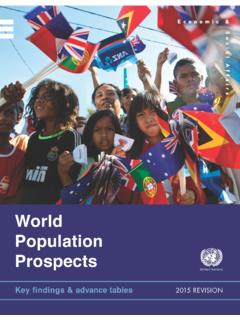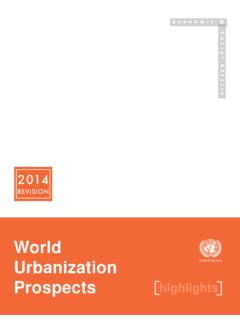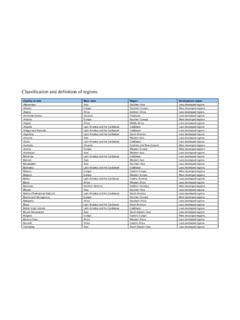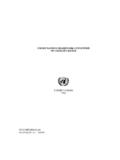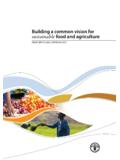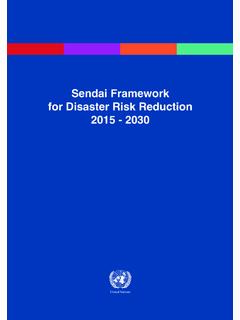Transcription of Key Findings WPP 2017 Final EMBARGOED - UN …
1 ESA/P/WP/248. Department of Economic and Social Affairs Population Division World Population Prospects The 2017 Revision Key Findings and Advance Tables united nations New York, 2017. DESA. The Department of Economic and Social Affairs of the united nations Secretariat is a vital interface between global policies in the economic, social and environmental spheres and national action. The Department works in three main interlinked areas: (i) it compiles, generates and analyses a wide range of economic, social and environmental data and information on which States Members of the united nations draw to review common problems and take stock of policy options; (ii) it facilitates the negotiations of Member States in many intergovernmental bodies on joint courses of action to address ongoing or emerging global challenges; and (iii) it advises interested Governments on the ways and means of translating policy frameworks developed in united nations conferences and summits into programmes at the country level and, through technical assistance, helps build national capacities.
2 Note The designations employed in this report and the material presented in it do not imply the expression of any opinion whatsoever on the part of the Secretariat of the united nations concerning the legal status of any country, territory, city or area or of its authorities, or concerning the delimitation of its frontiers or boundaries. Symbols of united nations documents are composed of capital letters combined with figures. This publication has been issued without formal editing. Suggested citation: united nations , Department of Economic and Social Affairs, Population Division (2017). World Population Prospects: The 2017 Revision, Key Findings and Advance Tables. Working Paper No. ESA/P/WP/248. Cover photo credit: Photo ID 14788. Iridimi Camp, Chad. UN Photo/Eskinder Debebe.
3 WORLD POPULATION PROSPECTS: THE 2017 REVISION. SUMMARY AND KEY Findings . People and therefore populations are at the centre of sustainable development and will be influential in the realization of the 2030 Agenda for Sustainable Development. The 2017 Revision of the World Population Prospects is the twenty-fifth round of official united nations population estimates and projections, which have been prepared since 1951 by the Population Division of the Department of Economic and Social Affairs of the united nations Secretariat. The 2017 Revision builds on previous revisions by incorporating additional results from the 2010 and 2020 rounds of national population censuses as well as Findings from recent specialized sample surveys from around the world. The 2017. Revision provides a comprehensive set of demographic data and indicators to assess population trends at the global, regional and national levels and to calculate many other key indicators commonly used by the united nations system.
4 Snapshot of global population in 2017. According to the results of the 2017 Revision, the world's population numbered nearly billion as of mid-2017 (table 1), implying that the world has added approximately one billion inhabitants over the last twelve years. Sixty per cent of the world's people live in Asia ( billion), 17 per cent in Africa ( billion), 10 per cent in Europe (742 million), 9 per cent in Latin America and the Caribbean (646 million), and the remaining 6 per cent in Northern America (361 million) and Oceania (41 million). China ( billion) and India ( billion) remain the two most populous countries of the world, comprising 19 and 18 per cent of the global total, respectively. TABLE 1. POPULATION OF THE WORLD AND REGIONS, 2017, 2030, 2050 AND 2100, ACCORDING TO THE MEDIUM-VARIANT PROJECTION.
5 Population (millions). Region 2017 2030 2050 2100. World .. 7 550 8 551 9 772 11 184. Africa .. 1 256 1 704 2 528 4 468. Asia .. 4 504 4 947 5 257 4 780. Europe .. 742 739 716 653. Latin America and the Caribbean .. 646 718 780 712. Northern America .. 361 395 435 499. Oceania .. 41 48 57 72. Source: united nations , Department of Economic and Social Affairs, Population Division (2017). World Population Prospects: The 2017 Revision. New York: united nations . At the global level, the numbers of men and women are roughly equal, with the male population being slightly larger than the female population. Currently, in 2017, there are 102 men for every 100. women. Thus, in a group of 1,000 people selected at random from the world's population, 504 would be male and 496 would be female on average (figure 1).
6 Children under 15 years of age represent roughly one quarter of the world's inhabitants (26 per cent), while older persons aged 60 or over account for just over one eighth (13 per cent). More than half (61 per cent) are adults between 15 and 59 years of age. If the total number of people were split in half according to the age distribution of the world's population (at the median age), one group would bring together all persons younger than 30 years of age, while the other would include everyone aged 30 years or older. united nations Department of Economic and Social Affairs/Population Division 1 World Population Prospects: The 2017 Revision, Key Findings and Advance Tables Figure 1. Distribution of the world's population by age and sex, 2017. 100+. Male Female 90-94. 80-84. 70-74.
7 60-64. 50-54. 40-44. 30-34. 20-24. 10-14. 0-4. 5 4 3 2 0 1 1 2 3 4 5. Percentage Source: united nations , Department of Economic and Social Affairs, Population Division (2017). World Population Prospects: The 2017 Revision. New York: united nations . Projected growth of the global population Today, the world's population continues to grow, albeit more slowly than in the recent past. Ten years ago, the global population was growing by per cent per year. Today, it is growing by per cent per year, yielding an additional 83 million people annually. The world's population is projected to increase by slightly more than one billion people over the next 13 years, reaching billion in 2030, and to increase further to billion in 2050 and billion by 2100 (table 1). Figure 2. Population of the world: estimates, 1950-2015, and medium-variant projection with 95 per cent prediction intervals, 2015-2100.
8 14. 95% prediction intervals Medium 12 Estimates 10. Population (billion). 8. 6. 4. 2. 0. 1950 1960 1970 1980 1990 2000 2010 2020 2030 2040 2050 2060 2070 2080 2090 2100. Source: united nations , Department of Economic and Social Affairs, Population Division (2017). World Population Prospects: The 2017 Revision. New York: united nations . 2 united nations Department of Economic and Social Affairs/Population Division World Population Prospects: The 2017 Revision, Key Findings and Advance Tables Theree is inherent uncertainty u in n population projections, p w which depend on assumptioons about plauusible future tren nds in specifiic demograph hic variables. The results ppresented abovve for future years are bassed on the mediu um-variant prrojection of the t 2017 Revvision, which assumes a ddecline of ferrtility for couuntries where larg ge families arre still prevallent, as well as a a slight inccrease of ferttility in severral countries wwhere women haave fewer thaan two live birrths on averag ge over a life time.
9 Survivaal rates are prrojected to inccrease in all cou untries as deatth rates contin nue to declin ne throughoutt the age rangge. The uncerrtainty surrouunding the projeccted trends inn fertility and d mortality has h been asse ssed using sttatistical methhods that gennerate statements about a ran nge of plausiible outcomess. For exampple, the analyysis has conccluded that, w with a certainty of 95 per cen nt, the size off the global poopulation willl stand betweeen and billion in 2030, between 9 and billion b in 205. 50, and betweeen and billion inn 2100 (figuree 2). Thus, thhe size of the wo orld's populaation is virtuaally certain to o rise over th the next few decades. Latter in the cenntury, although a continued increase of th he global poppulation is coonsidered thee most likelyy outcome, thhere is roughly a 27 per cent chance that the t world's population p couuld stabilize or even begiin to fall som metime before 2100.
10 Diversity y in populatio on growth ra ates across reegions More than half of the anticipateed growth in global popullation betweeen now and 22050 is expected to occur in Africa A (figure 3). Of the ad dditional billion b peoplee who may bee added betweeen 2017 and 2050, billion n will be addded in Africaa. Asia is exp pected to be tthe second laargest contribbutor to this ffuture growth, addding just over 750 million n people betwween 2017 annd 2050. Africca and Asia w will be followwed by Latin Am merica and the Caribbean, Northern N Ameerica and Oceeania, where growth is proojected to be much more mod dest. In the medium-varia m nt projection, Europe is thhe only regioon with a sm maller populatiion in 2050 thann in 2017. Bey yond 2050, Africa A will be the t main conttributor to gloobal populatioon growth.
